Those looking to better understand cultural appropriation and what is sacred to Indigenous peoples will have the opportunity to hear a presentation on the subject by Hupacasath First Nation woman Jolleen Dick on May 18.
Dick, whose traditional name is suuwayaqawilth which means “somebody that holds something precious for safe keeping,” is a council member for the Hupacasath First Nation and works in the tourism industry on Vancouver Island. She is a bead artist creating Indigenous jewellery inspired by her great grandma.
Dick brings her ancestors teachings and values into all of her work, which is about connecting with people and building relationships.
Her design practice draws inspiration from her maternal grandmother, who was a renowned seamstress, and her maternal great-grandmother who was a basket weaver. Dick pulls designs created by them both to produce contemporary beadwork.
Topics that will be discussed during Dick’s presentation include understanding what is sacred to Indigenous peoples and why you can’t wear certain items, understanding that purchasing authentic works is appreciation, authentic design work and theft of design work, repatriation and reviving Indigenous designs, crafts and materials.
“There is always room to continue understanding Nuu-chah-nulth peoples, our art, culture and experiences,” Dick said. “There is room for appreciation without appropriating designs by Indigenous peoples.”
Dick said it’s important to host a presentation on cultural appropriation and appreciation because typically, people don’t have the opportunity to explore these topics publicly and “often they rise during conflict and there are polarizing debates that happen in the wrong time and place.”
“Bringing people along for the learning journey in public sets the stage to reduce and mitigate the uncomfortable discussions that happen in the heat of the moment,” Dick said. “It’s about learning but also unlearning harmful ideas of what cultural appreciation is.”
Dick said she believes there are two main misconceptions around cultural appropriation. One being that people are purchasing products that they think are Indigenous but haven’t done the research to check the authenticity.
“Another is people play it safe and may choose not to purchase an Indigenous-made item thinking that only Indigenous people can wear designs,” Dick said. “At times this can be confused with wearing sacred regalia, which is generally off limits for use and wear outside of ceremony.”
Dick hopes people in attendance walk away from the presentation with an understanding of the teachings that go into creating and why authenticity matters.
“Theft of our materials and culture has been on-going since contact and we can disrupt that cycle by appreciating authentic Indigenous-made products and experiences,” she said.
The presentation: “Am I allowed to wear that? Understanding cultural appreciation and cultural appropriation” will take place in the Dogwood Room at Echo Centre on May 18 at 7 p.m. There is no cost to attend.







